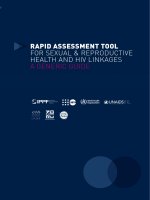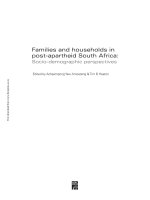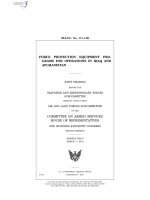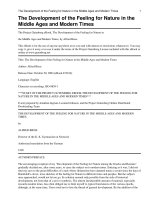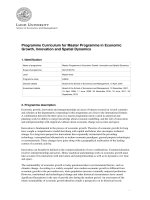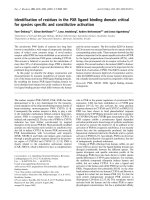Priorities for Investments in Children and Families in Caddo and Bossier Parishes doc
Bạn đang xem bản rút gọn của tài liệu. Xem và tải ngay bản đầy đủ của tài liệu tại đây (1.45 MB, 109 trang )
This document and trademark(s) contained herein are protected by law as indicated in a notice appearing later in
this work. This electronic representation of RAND intellectual property is provided for non-commercial use only.
Unauthorized posting of RAND PDFs to a non-RAND Web site is prohibited. RAND PDFs are protected under
copyright law. Permission is required from RAND to reproduce, or reuse in another form, any of our research
documents for commercial use. For information on reprint and linking permissions, please see RAND Permissions.
Limited Electronic Distribution Rights
This PDF document was made available from www.rand.org as a public
service of the RAND Corporation.
6
Jump down to document
THE ARTS
CHILD POLICY
CIVIL JUSTICE
EDUCATION
ENERGY AND ENVIRONMENT
HEALTH AND HEALTH CARE
INTERNATIONAL AFFAIRS
NATIONAL SECURITY
POPULATION AND AGING
PUBLIC SAFETY
SCIENCE AND TECHNOLOGY
SUBSTANCE ABUSE
TERRORISM AND
HOMELAND SECURITY
TRANSPORTATION AND
INFRASTRUCTURE
WORKFORCE AND WORKPLACE
The RAND Corporation is a nonprofit research
organization providing objective analysis and effective
solutions that address the challenges facing the public
and private sectors around the world.
Visit RAND at www.rand.org
Explore the RAND Gulf States Policy Institute
View document details
For More Information
GULF STATES POLICY INSTITUTE
A study by RAND Child Policy
Browse Books & Publications
Make a charitable contribution
Support RAND
This product is part of the RAND Corporation technical report series. Reports may
include research findings on a specific topic that is limited in scope; present discus-
sions of the methodology employed in research; provide literature reviews, survey
instruments, modeling exercises, guidelines for practitioners and research profes-
sionals, and supporting documentation; or deliver preliminary findings. All RAND
reports undergo rigorous peer review to ensure that they meet high standards for re-
search quality and objectivity.
GULF STATES POLICY INSTITUTE
A study by RAND Chil d Policy
Priorities for Investments in
Children and Families in
Caddo and Bossier Parishes
Application of a Unique Framework
for Identifying Priorities
M. Rebecca Kilburn, Shannon I. Maloney
Sponsored by the Community Foundation of Shreveport-Bossier
The RAND Corporation is a nonprofit research organization providing objective analysis
and effective solutions that address the challenges facing the public and private sectors
around the world. RAND’s publications do not necessarily reflect the opinions of its
research clients and sponsors.
R
®
is a registered trademark.
© Copyright 2010 RAND Corporation
Permission is given to duplicate this document for personal use only, as long as it is unaltered
and complete. Copies may not be duplicated for commercial purposes. Unauthorized
posting of RAND documents to a non-RAND Web site is prohibited. RAND
documents are protected under copyright law. For information on reprint and linking
permissions, please visit the RAND permissions page (
permissions.html).
Published 2010 by the RAND Corporation
1776 Main Street, P.O. Box 2138, Santa Monica, CA 90407-2138
1200 South Hayes Street, Arlington, VA 22202-5050
4570 Fifth Avenue, Suite 600, Pittsburgh, PA 15213-2665
RAND URL:
To order RAND documents or to obtain additional information, contact
Distribution Services: Telephone: (310) 451-7002;
Fax: (310) 451-6915; Email:
This research was sponsored by the Community Foundation of Shreveport-Bossier and was
conducted within RAND Child Policy and in collaboration with the RAND Gulf States
Policy Institute.
iii
Preface
In Louisiana, the Community Foundation of Shreveport-Bossier pools funds
from sources in Caddo and Bossier Parishes, manages the funds, and allocates
the funding within the region. (The City of Shreveport is in Caddo Parish; the
City of Bossier City is
in Bossier Parish.) The foundation recently identified three
priority areas for foundation funding: education, health, and poverty. Before
launching a campaign to encourage additional community investment in these
three funds and prior to issuing grants from them, the foundation engaged in a
strategic review of options for making the best use of these funds. The
foundation emphasizes the use of data from local and national sources that can
steer its gifts toward investments that have the greatest likelihood of making
meaningful improvements in the lives of the citizens of the region. The
foundation asked the RAND Corporation to assist the community in identifying
priority strategies within the three focus areas. This document reflects the
findings of the joint work of the foundation, RAND, and the community to
narrow the set of activities to which the funds would initially be directed.
While the primary target audience for this report is the Community Foundation
and individuals in the Shreveport–Bossier City area, this report is also likely to
be useful to others who need to prioritize public or private investments in a
broad range of areas. The “Needs-Assets-Best Practices” framework developed
to assist with the Shreveport-Bossier investment decisions can be applied in
many other settings as well; this document can be viewed as a case study of the
application of that framework.
This research was conducted within RAND Child Policy and in collaboration
with the RAND Gulf States Policy Institute. For inquiries related to RAND Child
Policy, please contact Rebecca Kilburn at For inquiries related
to the RAND Gulf States Policy Institute, please contact Melissa Flournoy at
RAND’s corporate Office of Research Quality Assurance
oversaw quality assurance and blind peer review for this publication.
v
Contents
Preface iii
Figures vii
Tables ix
Summary xi
Approach xi
Framework xii
Findings xiii
Acknowledgments xvii
Abbreviations xix
1. Introduction 1
How Does a Community Set Priorities? 1
Framework for Prioritizing 3
Outline of This Document 4
2. Approaches to Identifying Priority Investments 5
Needs Assessment 5
Identifying Needs 6
Measuring Needs 8
Assessing Needs 8
Our Approach to Needs Assessment 10
Strengths and Weaknesses of This Approach 12
Identifying Assets 12
Best Practices 14
The Intersection of Needs, Assets, and Best Practices 16
3. Findings 19
Needs Assessment 19
Infant Health 19
Child Maltreatment 21
Academic Performance and Educational Attainment 24
Identifying Assets 27
Best Practices 30
Infant Health 30
Educational Attainment 32
Child Maltreatment 33
4. Recommendations: The Intersection of Needs, Assets, and Best
Practices 39
APPENDIXES
A. Other Needs Assessment Graphs 45
B. Needs Indicator Data Sources 60
vi
vi
Health Indicator Data Sources 60
Education Indicator Data Sources 66
Poverty Indicator Data Sources 75
C. Dates and Agenda for Community Meetings 80
References 82
vii
Figures
Figure S.1 Framework for Investment: Intersection of Need, Assets, and
Best Practices xiii
Figure 1.1 Framework for Investment: Intersection of Need, Assets, and
Best Practices 4
Figure 3.1 Preterm Births 20
Figure 3.2 Infant Mortality 21
Figure 3.3 Child Neglect 22
Figure 3.4 Physical Abuse 23
Figure 3.5 Sexual Abuse 24
Figure 3.6 Math Proficiency, 4
th
Grade 25
Figure 3.7 Math Proficiency, 8
th
Grade 26
Figure 3.8 High School Dropout Rates 27
Figure 4.1 Evidence-Based Strategies Are Those That Address Identified
Needs and Draw on Community’s Assets 40
Figure A.1 Students’ Proficiency in English Language 45
Figure A.2 Portion of Median Income Needed to Cover the Cost of Infant
Child Care 46
Figure A.3 Pre-Kindergarten Enrollment 46
Figure A.4 Babies Born Weighing Less Than 2,500 Grams 47
Figure A.5 Portion of Population Living Below Federal Poverty Level 47
Figure A.6 Portion of Children in Families Living Below Federal Poverty
Level 48
Figure A.7 Portion of Labor Force That Is Unemployed 48
Figure A.8 Portion of Children in Poverty That Receive Food Stamps 49
Figure A.9 Median Household Income 49
Figure A.10 Students in Families That Qualify for Free or Reduced Price
Lunch 50
Figure A.11 Portion of Population in Poverty That Received EITC 50
Figure A.12 Portion of Children in Poverty Enrolled in Medicaid 51
Figure A.13 Babies Born to Teenage Mothers 51
Figure A.14 Portion of Children Current on Immunizations at 24 Months 52
Figure A.15 Babies Born to Mothers Who Received Early and Adequate
Prenatal Care 52
Figure A.16 Portion of Children Not Covered by Health Insurance 53
Figure A.17 12
th
Graders Who Reported Smoking at Least Once in 30
Days 53
Figure A.18 12
th
Graders Who Reported Binge Drinking Behavior 54
Figure A.19 8
th
Graders Who Reported Binge Drinking Behavior 54
Figure A.20 Average Teacher Salary in Public Schools 55
Figure A.21 English Language Arts Proficiency, 8
th
Grade 55
Figure A.22 English Language Arts Proficient, 4
th
Grade 56
Figure A.23 Public School Faculty with a Master’s Degree 56
Figure A.24 Percentage of 12
th
Graders That Graduate Senior Year 57
Figure A.25 Public School Expenditures per Student 57
Figure A.26 First Time Freshman in College 58
Figure A.27 Average Overall ACT Score 58
viii
viii
Figure A.28 Percentage of Public Schools with Classrooms of 20 Students
or Less 59
Figure A.29 Elementary and Secondary School Attendance 59
ix
Tables
Table S.1 Evidence-Based Strategies at the Intersection of Region’s Needs
and Assets xiv
Table 3.1 Program Components Associated with Effective Parent
Training 36
Table 4.1 Evidence-Based Strategies at the Intersection of Region’s Needs
and Assets 41
Table B.1 Health Indicator Data Sources 60
Table B.2 Education Indicator Data Sources 66
Table B.3 Poverty Indicator Data Sources 75
xi
Summary
After an initial inventory of community indicators in its 2008 Shreveport–Bossier
City Community Counts annual report, the Community Foundation of
Shreveport-Bossier decided to focus existing funding related to children and
families on the areas of education, health, and poverty, as well as develop new
funds in these areas. These focal areas were very broad, and the foundation
realized that further prioritization was required to inform the distribution of the
funds in a way that would provide the most benefit to the community. In early
2009, the foundation asked the RAND Corporation to assist with further
refinement of priorities for investments, with an emphasis on children and
families. In addition to informing the development of funds for the Community
Foundation, the findings of this report are likely to be of interest to the broader
Shreveport–Bossier City community. Furthermore, the approach used to refine
priority areas of investment for this community may be of interest to other
communities seeking to prioritize their own investments in children and families.
Approach
We began early in 2009 by convening a series of community meetings, which
allowed us to obtain input from community members on the values that should
guide a framework for prioritizing investments in children and families. While
the Community Foundation would ultimately oversee the disbursement of
funds, the foundation wanted the priorities to reflect community values. A broad
set of stakeholders in the community joined the meetings: nonprofit
organizations that serve children and families, local businesses, grantmakers,
faith-based organizations, school districts, volunteer organizations,
postsecondary institutions, Latino and African-American organizations,
women’s organizations, health care providers, early education institutions,
justice and law enforcement organizations, government agencies, representatives
from the foundation, and others. A few preferences emerged in terms of the
relative value placed on different factors that should contribute to selecting
priority investments in this community. Community members placed greater
emphasis on data and evidence rather than public opinion as a desirable
construct for identifying community needs. Furthermore, discussion participants
indicated that addressing areas of greatest need was a priority. Individuals also
expressed a preference for directing resources toward activities that had been
established as “best practices” through evidence-based research.
xii
In parallel with this series of dialogues with community stakeholders, we also
conducted a literature review encompassing different strategies for prioritizing
investments. We review three major approaches that have been used in similar
contexts: assessing needs, inventorying assets, and documenting best practices.
Needs assessment generally involves focusing on the outcomes for which the
geographic area does the “worst”—or exhibits the greatest “needs”—relative to
some comparison group, such as other, similar communities. The asset inventory
approach would emphasize building on community strengths that are available
for improving child and family outcomes, and these strengths may include an
available workforce, infrastructure, volunteer sector, or other community
resources. A third popular approach to prioritizing investments has been to
employing strategies for which a solid evidence base has demonstrated the
potential for effectiveness, so that scarce resources are committed to strategies
that have the greatest probability of having an impact.
Framework
Based on the values that community members expressed in the meetings and the
results of our literature review, we developed a unique framework to guide the
process of identifying priority investments for the community. Rather than
selecting the “best” approach from the three major approaches identified in the
literature review, we proposed that these approaches be combined into a
framework that could be used to narrow the priorities. All three approaches—
needs assessment, asset inventory, and best practices—have strengths and
include components that the community values. The framework we used to
identify priorities for investment in children and families finds strategies that are
at the intersection of community needs, community assets, and evidence-based
best practices (see Figure S.1). While each of these three standards has been
extensively used in the past as a way to guide community investments, this is
one of the first instances of which we are aware in which all three are used
simultaneously as the organizing principle for prioritizing investments from a
broad range of potential areas.
With this framework as a guide, we systematically reviewed data and
information related to each of the three approaches in order to objectively
identify strategies at their intersection. We reviewed existing secondary data on
child and family well-being in the two parishes to pinpoint the outcomes for
which the community exhibited the greatest needs. Then we reviewed data on
the assets that the community could mobilize to address these needs. Last, we
consulted evidence-based research from across the country to locate effective
xiii
strategies for addressing the areas of greatest need with the resources available in
the community.
Figure S.1
Framework for Investment: Intersection of Need, Assets, and Best Practices
Findings
The analysis identified three priority areas of need for children and families in
the Shreveport–Bossier City area:
• infant health
• educational attainment
• child maltreatment.
The strongest assets in the area that may represent opportunities for improving
the well-being of children and families include these resources:
• large quantity of health care facilities and health care providers
• public school teachers and schools
• Barksdale Air Force Base.
Needs in Shreveport-
Bossier area
Assets to deploy
for investment
Best practices
Prioritize
strategies in
this area
xiv
Finally, evidence-based research indicates that there are a number of effective
approaches to improving the areas of need. Table S.1 below indicates the type of
approaches that could address the areas of need while taking advantage of the
area resources.
We recommend that the Community Foundation consider some next steps to
promote their goals of putting their funds to best use. These include creating
workgroups to develop plans for implementing investments in the areas
identified by this research, identifying specific programs and policies that could
be used to implement the priority strategies, and communicating that
information to relevant community stakeholders.
Table S.1
Evidence-Based Strategies at the Intersection of Region’s Needs and Assets
Area of Need
Assets
Infant Health
Educational
Attainment
Child
Maltreatment
Health care
facilities and
providers
- Improving
women’s
preconception
and
interconception
health
- Pregnancy
screening and
healthy
pregnancy
behaviors
- Parent education
and home
visitation
programs
- Parent education
and home
visitation
programs
Public schools
and teachers
- Educating
young women on
preconception
and
interconception
health
- Mentoring,
counseling
- Smaller group
settings and
personalized
instruction
- Interventions
- Skill-based
curricula or life
skills training for
children and
youth
xv
emphasizing
behavioral change
- Academic-
focused intensive
programs
- Data systems to
monitor trends
and identify at-
risk students
Barksdale Air
Force Base
- Same
approaches as in
health care sector
- Train spouses to
provide education
and home visiting
services
- Provide mentors
for preteens and
teens
- Base awareness
campaigns
- Parent education
and home
visitation
programs
xvii
Acknowledgments
We are grateful to the many individuals in the Shreveport–Bossier City
community that contributed to the dialogue in the many community meetings
that took place as part of this project in 2009. While we do not name each of these
individuals here, we want to give special thanks to a few people who, in addition
to contributing to the dialogue, hosted meetings, distributed meeting
announcements, critiqued early versions of the format of the data presentations,
or made other special contributions. First, we would like to acknowledge our
colleague and leader of the RAND Gulf States Policy Institute, Melissa Flournoy,
for her tireless leadership of the community meetings and other project
leadership. We also thank Kay Irby and Helen Wise for hosting meetings at the
Louisiana Association of Nonprofits and Louisiana State University–Shreveport,
respectively, and for publicizing the meetings. Helen Wise and Becky Berry
created the 2008 Community Counts publication, which served as a springboard
for the foundation’s investment prioritization, and which we also cite extensively
in this report. We also thank Helen, Becky, Liz LaBorde, and Terry Davis for
reviewing data formats, suggesting data sources, and providing other ongoing
input during the project. We thank Stacy Fitzsimmons for administrative
assistance during the project, and Lance Tan for assistance in preparing this
document. Special thanks are due to the Promising Practices Network (PPN)
team, and particularly Rebecca Shaw of RAND, who manages the project, as the
PPN’s products are the foundation of the “Best Practices” section in Chapter
Two. We very much appreciate the quality assurance oversight of Rick Eden as
part of RAND’s Office of Research Quality Assurance, and we appreciate the
extremely constructive reviews from two anonymous peer reviewers.
Finally, we would like to acknowledge the energetic and attentive support,
feedback, and leadership of Paula Hickman, the Executive Director of the
Community Foundation of Shreveport-Bossier, throughout the course of this
project.
xviii
Abbreviations
ACT
American College Testing
CDC
Centers for Disease Control and Prevention
EITC
Earned Income Tax Credit
GTO
Getting To Outcomes
IES
Institute of Education Sciences
LBW
low birth weight
LEAP
Louisiana Educational Assessment Program
NAEP
National Assessment of Education Progress
NCCAN
National Center on Child Abuse and Neglect
NDAS
National Data Analysis System
PPN
Promising Practices Network on Children, Families, and
Communities
SAMHSA
Substance Abuse and Mental Health Services
Administration
VA
Department of Veterans Affairs
1
1. Introduction
In Louisiana, the Community Foundation of Shreveport-Bossier pools funds
from sources in the Caddo and Bossier parishes, manages the funds, and
distributes gifts in the region. (The City of Shreveport is in Caddo Parish; the City
of
B
ossier City is in Bossier Parish.) Since 1961, the foundation has distributed
over $35 million in the region. In 2008, the foundation sponsored the first annual
Shreveport–Bossier City Community Counts annual report, which presented 13
social indicators that reflected economic development and the well-being of
citizens in the region (Community Foundation of Shreveport-Bossier, 2008).
Based on the findings of this report, the Board of Directors and the staff of the
foundation identified three areas of focus for foundation gifts: education, health,
and poverty. These three areas were selected out of the larger set of indicators
because they exhibited the greatest challenges to the region. In addition to
focusing existing grantmaking related to children and families on these areas, the
foundation also planned to create new investment funds for each of these areas.
Before launching a campaign to encourage additional community investment in
these three funds and prior to issuing grants from them, the foundation
leadership decided to engage in a strategic review of options for making the best
use of these funds. The foundation emphasizes the use of data from local and
national sources that can steer its gifts towards investments that have the greatest
likelihood of making meaningful improvements in the lives of the citizens of the
region. The foundation asked the RAND Corporation to assist the community in
identifying priority strategies within the three funds. This document reflects the
findings of the joint work of the foundation, RAND, and the community to
narrow the set of activities to which the funds would initially be directed.
How Does a Community Set Priorities?
There are many alternative approaches that a community can use to select
priorities (see discussion in Kilburn and Karoly, 2008). These alternatives
encompass different values in terms of how to weight different types of data,
outcomes, time horizons, and other factors that play into community investments
in children and families. For example, some communities may value public
opinion more heavily, while other communities may prefer to rely on
demographic data. Some communities may insist on a short time horizon, while
others may take a longer-term planning approach.
2
We began the project by hosting a series of community meetings in the first half
of 2009 to obtain input and gauge the collective values of the key stakeholders.
These stakeholders included individuals from these sectors of the community:
nonprofit organizations that serve children and families, local businesses,
grantmakers, faith-based organizations, school districts, volunteer organizations,
postsecondary institutions, Latino and African-American organizations,
women’s organizations, health care providers, early education institutions,
justice and law enforcement organizations, local government agencies,
representatives from the foundation, and others. We aspired to include in these
discussions a diverse spectrum of potential viewpoints, individuals from both
the private and public sector, representatives from all types of systems that serve
children and families (health care, criminal justice, education, etc.), and
individuals from underserved communities. We consulted with the foundation,
the Louisiana Association of Nonprofit Organizations, individuals from local
institutions of higher education, and others to obtain suggestions about who
might be willing to participate in the meetings. Meeting invitations were usually
distributed to about 100 people via email, and we were generally pleased with
the diversity of roles, organizations, and sectors represented at the meetings. We
recognize that the link between the project and the community was the
Community Foundation. The implication of this is that the individuals who
participated in the discussions may not have been a random group of
individuals, organizations, or viewpoints and may have had views that were
similar to those of the foundation.
In these discussions, a few preferences emerged in terms of the relative value
placed on different factors that contributed to selecting priority investments. One
such preference was that the participants placed greater emphasis on data rather
than public opinion as the appropriate guide for identifying community needs. A
second preference was that addressing areas of greatest need should be a
priority. A third preference that individuals emphasized in these community
meetings was that resources be directed toward activities that had been
established as “best practices” through evidence-based research. This was often
articulated as a desire to use all available information to make the most of limited
resources, rather then “reinvent the wheel,” and to make sure that the
investments yielded the best possible improvements for children and families.
We provide a brief overview of the meeting dates and agendas in Appendix C.
Several other community dialogues were taking place during 2009, including
community meetings to obtain input for a Shreveport Master Plan project, as
well as discussions related to schools and school district activities, and other
community initiatives. We either ensured that a project representative attended
3
some of these other discussions or reviewed notes from them in order to capture
any additional information that was relevant to our work. Throughout this
process, we aimed to balance our conviction that community input was
invaluable with community members’ concerns that more discussion was taking
place than action.
Framework for Prioritizing
As discussed in more detail below, we also conducted a literature review on
alternative approaches to prioritizing community investments, with an emphasis
on those directed toward children and families. We combined the information
from the literature review with the factors that the Shreveport-Bossier
community valued to develop a unique framework to guide decisionmaking on
this issue. We proposed a hybrid approach that combines several of the
traditional ways of choosing priorities and, as a result, takes advantage of the
strengths of each approach. At the same time, this framework incorporates
information from existing secondary data about the community and also draws
on best practices from around the country.
Specifically, we have used a framework that identifies priorities for investment in
children and families by finding the strategies that are at the intersection of
community needs, community assets that can be deployed for improving child
and family well-being, and evidence-based best practices for improving
children’s outcomes. While each of these three standards has been extensively
used in the past as a way to prioritize community investments from a broader set
of possibilities, this is one of the first instances of which we are aware in which
all three are used simultaneously as the organizing principle for prioritizing
areas for investment.
Using this framework as a guide, we systematically reviewed data and
information related to each of the three approaches in order to objectively
determine what was at the intersection (see Figure 1.1). First, we reviewed
existing secondary data on child and family well-being in the two parishes
encompassing Shreveport and Bossier to discover the outcomes of greatest need
for the community. Second, we reviewed data on the assets that the community
could bring to bear to address these needs. Finally, we consulted evidence-based
research from across the country to identify effective strategies for intervening to
address the areas of greatest need with assets available in the community.
4
Figure 1.1
Framework for Investment: Intersection of Need, Assets, and Best Practices
Outline of this Document
Chapter Two provides an overview of the three approaches to prioritizing
investments that form the foundation for the framework used by this project.
These include needs assessment, identifying assets, and best practices. Chapter
Three presents our findings from using data to pinpoint the intersection of needs,
assets, and best practices. Chapter Four concludes with recommendations based
on the research.
Needs in Shreveport-
Bossier area
Assets to deploy
for investment
Best practices
Prioritize
strategies in
this area
5
2. Approaches to Identifying Priority
Investments
This chapter provides an overview of the three major approaches to identifying
priority investments that our framework draws upon. These include needs
assessment, identifying assets, and best practices. The chapter ends by
contrasting this “Needs-Assets-Best Practices” framework, which helps
communities prioritize areas for investment, with some frameworks that provide
communities with guidance about how to implement interventions once they
have identified their priority investments. These implementation frameworks
incorporate aspects of community needs and capacity as well as evidence-based
practice guidelines, and communities may find these useful as they embark on
next steps.
Needs Assessment
Faced with a vast array of options for spending within a limited budget,
community organizations must choose which programs to fund and which to
leave behind. How to make this choice in an equitable or efficient way is not
always clear. Needs analysis provides a data-oriented platform for making
strategic funding decisions.
Needs analysis is the process of identifying and prioritizing deficiencies so that
an agency or community organization can allocate its resources for the greatest
benefit (Harlow and Turner, 1993). The concept of a “need analysis” originated
in the 1960s (Kimmel, 1977) out of legislators’ desires to be more selective about
which social programs they funded. Rather than fund all proposed initiatives,
legislators sought to make public spending more efficient by focusing on
programs that offered evidence to support their existence. For a program to
receive funding, it had to demonstrate a need for the services offered and show
that the program itself was effective (Kimmel, 1977). Together, these
requirements aim to provide an objective and logical framework for establishing
the need for programs and the likelihood that program spending would have an
impact.
Despite intentions to infuse program spending decisions with logic and clarity,
needs analyses require decisionmakers to make value judgments about need.
What constitutes a need depends on the goals, values, and perspective of the
person or entity defining the need (McKillip, 1987). For example, a community
